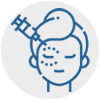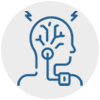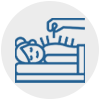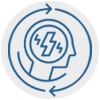Explore this page:

Osteopathy – Overview
Osteopathy is a branch of alternative medicine which is focused on treatment of abnormalities of body posture and mechanics. Practitioners of osteopathy, referred to as osteopaths, practice manipulation of muscle tissue and bones, and examine soft tissues to evaluate joint function. Moreover, this branch of medicine uses a holistic, whole-body approach to healthcare.
Osteopathy emphasizes correction of abnormal and dysfunctional movements, reducing pain and promoting healing. Typically, techniques used in osteopathic treatment include application of gentle pressure, stretching, and resistance, together known as “osteopathic manipulative medicine.”
What Conditions can be Treated with Osteopathy?
Osteopathy can be used to effectively treat a wide range of painful conditions, specifically those involving the joints, muscles, and spine.
Conditions that respond to osteopathy treatment include the following:
- Back pain
- Carpal tunnel
- Tennis elbow
- Plantar fasciitis
- Patellofemoral syndrome
- Headaches
- Chronic migraines
How are Patients Diagnosed?
Like medical doctors, osteopathic physicians also rely on the patient’s medical history. Most osteopathy practitioners ask patients about their activities — both at home and at work — as well as about their diet, sleep patterns, and how they handle stress. This is followed by a thorough physical examination, including any necessary imaging studies or lab work, in order to make a diagnosis. Moreover, the patients are carefully monitored during and after treatment to evaluate any improvements to confirm the diagnosis.
Osteopathic Treatment for Chronic Pain Relief
The scope of osteopathy treatment depends on the patient’s needs. Typically, the treatment focus is on fascial release using techniques such as strain/counter strain, proprioceptive neuromuscular facilitation and muscle energy techniques.
Proprioreceptive neuromuscular facilitation (PNF) is a hands-on technique where the therapist matches and counters the muscle contraction effort of the patient to achieve an isometric type of exercise.
The carefully ordered application of osteopathy therapy can correct the firing pattern of muscle groups, providing balance to the soft tissues around a joint. The idea behind these approaches is to apply a small but precise amount of force to promote movement of tissue fluids and to release compression and other abnormal forces acting on the muscles and joints.
Osteopaths also perform osteoarticular adjustment using a low-velocity, low-amplitude movement to adjust the bones and joints, including the spine and hips. This technique involves the use of a gently applied impulse to allow the strained articulation to return to its natural position and function.
Moreover, the patient is given a series of home exercises to reinstate the correct muscle firing patterns and to prevent the problem from returning. These exercises may change as the patient’s muscles strengthen over time.
Custom orthotics can also be used to help support abnormally lax plantar and ankle joint ligaments, which might be triggering compensation up to the entire kinetic chain.
Treatment Procedure
Our approach is to step back and assess the entire patient. Symmetry, ease and efficiency of movement are noted. We do a neurologic and orthopedic examination — not just for the presenting area but also for all the areas that may influence or be affected by the painful part.
The physical exam is a search for underlying abnormal forces that cause structural malalignments. For example, many patients with back pain have abnormalities of their gait, including weakened plantar fascia (so-called fallen arches) and/or abnormal leg, knee and hip movements.
Osteopaths usually find several problems, all triggering other issues in a vicious cycle. As a result, we place special emphasis on the spine because of the role it plays in stabilizing the body. Every level is assessed for movement in all three dimensions.
The physical exam includes a test of the range of motion of the joints, both passive and active. Most importantly, soft tissues are examined for dysfunctions such as muscle over- or under-activity, inflammation, scar tissue, poor local circulation, congestion, abnormal nerve function.
To learn more about how custom orthotics can help you, contact our friendly staff at the Headache, Migraine & Concussion Centre. Our team of specialists can help you determine if custom orthotics are the right solution for you. Call us to schedule your appointment at 905-477-4677.






